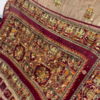A **Gharchola saree** is a traditional Indian saree, originating from Gujarat, and is deeply rooted in the culture and customs of the region. It is particularly popular during weddings and religious ceremonies due to its symbolic and aesthetic significance.
### Key Features of a Gharchola Saree:
1. **Fabric:**
– Typically made of **silk** or **cotton-silk blend**, which is lightweight, soft, and durable.
– Variants in pure **bandhani silk** are also common.
2. **Design:**
– **Grid Patterns (Checks):** The hallmark of a Gharchola saree is its grid-like design, created using woven zari (gold or silver thread).
– Each square in the grid often features traditional motifs like **elephants, peacocks, lotus flowers, or geometric patterns**.
– These motifs hold cultural and auspicious significance.
3. **Technique:**
– Created through the **tie-and-dye (Bandhani)** process, where parts of the fabric are tied and dyed in vibrant colors.
– The zari work is incorporated either during weaving or as an embellishment over the dyed fabric.
4. **Colors:**
– Traditional colors include **red, maroon, green**, and **yellow**, symbolizing joy, prosperity, and auspiciousness.
– Modern adaptations also feature pastel shades and unique color combinations.
5. **Cultural Significance:**
– Widely used in **Gujarati weddings**, often worn by the bride during marriage rituals.
– Represents **good luck and prosperity**, making it a cherished family heirloom.
6. **Styling Tips:**
– Pair with traditional **gold or kundan jewelry** for an authentic look.
– Choose a well-fitted blouse with minimal embroidery to complement the intricate saree design.
– Accessories like a maang tikka, bangles, and a waist belt can enhance the bridal appeal.
Would you like tips on purchasing an authentic Gharchola saree or ideas for styling it for a specific occasion?




































Reviews
There are no reviews yet.